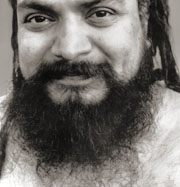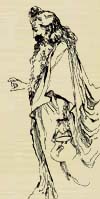Stories in Yoga Vasishta
Vasishta spends considerable time answering Rama’s questions and lecturing on various spiritual subjects, but most of Yoga Vasishta is stories that illustrate the nature of reality. These stories, like similes and metaphors, serve to impress understanding upon the mind.
The first long story is in Book III and is about Queen Leela and King Padma. (III.15-58, with a twist on the ending in VIB.156-157) They lead an idyllic life, but as they age Leela fears he might die first, in which case her own life would be intolerable. So she does tapas to Goddess Saraswati and obtains the boon to have her husband’s spirit always with her. She and the goddess astral travel and time travel to see the couple’s prior life as simple brahmins, and the origin of her husband’s desire to possess the wealth of an empire. That desire manifests after King Padma dies and the queen and goddess see another reality in the deceased king’s mind. He is now King Viduratha ruling a vast empire with a second Leela as his wife, then battling his enemy King Sindhu. In the end, King Sindhu wins, King Viduratha is killed, King Padma is brought back to life in front of the two Leelas, and both Padma and the first Leela attain nirvana.
The story of Gadhi (V.44-49) is much shorter and involves one of those moments in which a person experiences another lifetime. Gadhi the brahmin looses consciousness and wakes up as a child in the womb of a tribal woman. He lives a lifetime among tribals until he outlives his contemporaries, then wanders to a rich city, Kira. The king of that city had recently died, so the citizens decided to let the royal elephant chose the successor. The elephant chose Katanja (Gadhi) and he became king. After eight years of rule, the citizens discovered the king was a tribal, so brahmins and ministers began immolating themselves in disgust. The tribal who became king does the same, and as he throws himself on his own funeral pyre, Gadhi the brahmin wakes up only to realize that his entire life as a tribal was a brief daydream.
But the dream seemed so real that Gadhi goes to where he lived as a tribal, then where he ruled as king. He explores and interviews and realizes that it had all really happened. He does tapas to Lord Vishnu who tells him it was just in his mind. Gadhi ends up travelling there three times. Each time his daydream is confirmed, and after each time he does tapas and Vishnu tells him it was only in his mind.
In Book VI Part 2, Vasishta tells a story of a sage entering the consciousness of a student in order to explore the nature of dreams. The story includes narrations by the sage, Agni (the god of fire), Vasishta himself, two unnamed sages (one the dream of the other), and a hunter who becomes the cosmos, is destroyed as the end of the world, then reincarnates as a character in the Queen Leela story. It is within this story that Vasishta weaves his own personal experiences the most obviously.
There is the story of the ten Aindava bothers. All ten become God the Creator, the sole God of the Universe, at the same time.
Then there is King Vipaschit who makes himself into four, wages war successfully, then his four persons get lost in repeated reincarnations. One of those four persons ends up as a deer who Vasishta restores to a human form before the amazed Rama and the assembled court. That former deer tells the court about his own experiences as King Vipaschit and all the many other incarnations of his four copies.
In another part of the book, Sage Bhushunda, a crow who is the only point of consciousness that has survived countless cycles of creation and dissolution, explains how there have been many Creators, many Shivas and Vishnus, and many incarnations of the personality of Vasishta, Rama and all the other sages and avatars. This has all happened before, many times.
There are many, many such stories. You can read some of them in their entireties as the Yoga Vasishta Stories page.
![]()

